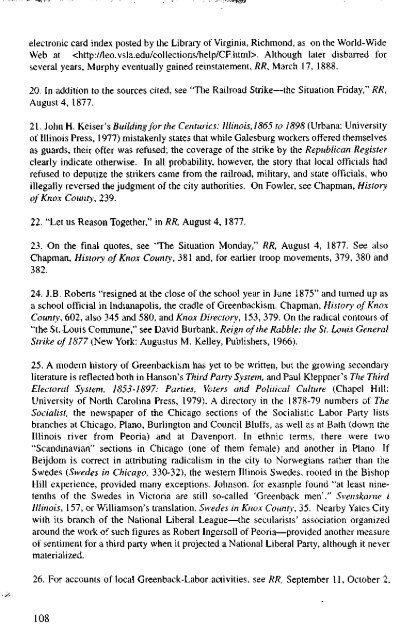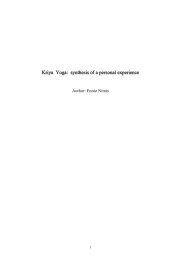"The Cruel Striker War" - NIU Digital Projects
"The Cruel Striker War" - NIU Digital Projects
"The Cruel Striker War" - NIU Digital Projects
Create successful ePaper yourself
Turn your PDF publications into a flip-book with our unique Google optimized e-Paper software.
electronic card index posted by the Library of Virginia, Richmond, as on the World-Wide<br />
Web at . Although later disbarred for<br />
several years, Murphy eventually gained reinstatement, RR, March 17, 1888.<br />
20. In addition to the sources cited, see "<strong>The</strong> Railroad Strike—the Situation Friday," RR,<br />
August 4, 1877.<br />
21. John H. Keiser's Building for the Centuries: Illinois, 1865 to 1898 (Urbana: University<br />
of Illinois Press, 1977) mistakenly states that while Galesburg workers offered themselves<br />
as guards, their offer was refused; the coverage of the strike by the Republican Register<br />
clearly indicate otherwise. In all probability, however, the story that local officials had<br />
refused to deputize the strikers came from the railroad, military, and state officials, who<br />
illegally reversed the judgment of the city authorities. On Fowler, see Chapman, History<br />
of Knox County, 239.<br />
22. "Let us Reason Together," in RR, August 4, 1877.<br />
23. On the final quotes, see "<strong>The</strong> Situation Monday," RR, August 4, 1877. See also<br />
Chapman, History of Knox County, 381 and, for earlier troop movements, 379, 380 and<br />
382.<br />
24. J.B. Roberts "resigned at the close of the school year in June 1875" and turned up as<br />
a school official in Indianapolis, the cradle of Greenbackism. Chapman, History of Knox<br />
County, 602, also 345 and 580, and Knox Directory, 153, 379. On the radical contours of<br />
"the St. Louis Commune," see David Burbank, Reign of the Rabble: the St. Louis General<br />
Strike of 1877 (New York: Augustus M. Kelley, Publishers, 1966).<br />
25. A modern history of Greenbackism has yet to be written, but the growing secondary<br />
literature is reflected both in Hanson's Third Party System, and Paul Kleppner's <strong>The</strong> Third<br />
Electoral System, 1853-1897: Parties, Voters and Political Culture (Chapel Hill:<br />
University of North Carolina Press, 1979). A directory in the 1878-79 numbers of <strong>The</strong><br />
Socialist, the newspaper of the Chicago sections of the Socialistic Labor Party lists<br />
branches at Chicago, Piano, Burlington and Council Bluffs, as well as at Bath (down the<br />
Illinois river from Peoria) and at Davenport. In ethnic terms, there were two<br />
"Scandinavian" sections in Chicago (one of them female) and another in Piano. If<br />
Beijdom is correct in attributing radicalism in the city to Norwegians rather than the<br />
Swedes (Swedes in Chicago, 330-32), the western Illinois Swedes, rooted in the Bishop<br />
Hill experience, provided many exceptions. Johnson, for example found "at least ninetenths<br />
of the Swedes in Victoria are still so-called 'Greenback men'." Svenskarne i<br />
Illinois, 157, or Williamson's translation, Swedes in Knox County, 35. Nearby Yates City<br />
with its branch of the National Liberal League—the secularists' association organized<br />
around the work of such figures as Robert Ingersoll of Peoria—provided another measure<br />
of sentiment for a third party when it projected a National Liberal Party, although it never<br />
materialized.<br />
26. For accounts of local Greenback-Labor activities, see RR, September 11, October 2,<br />
108

















